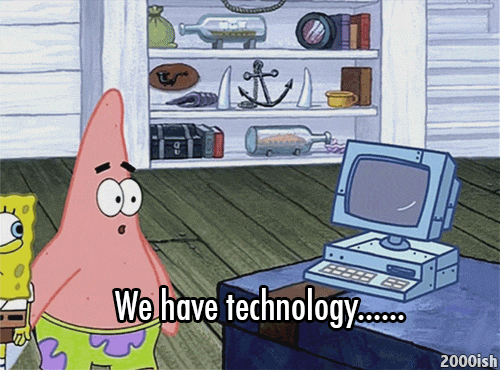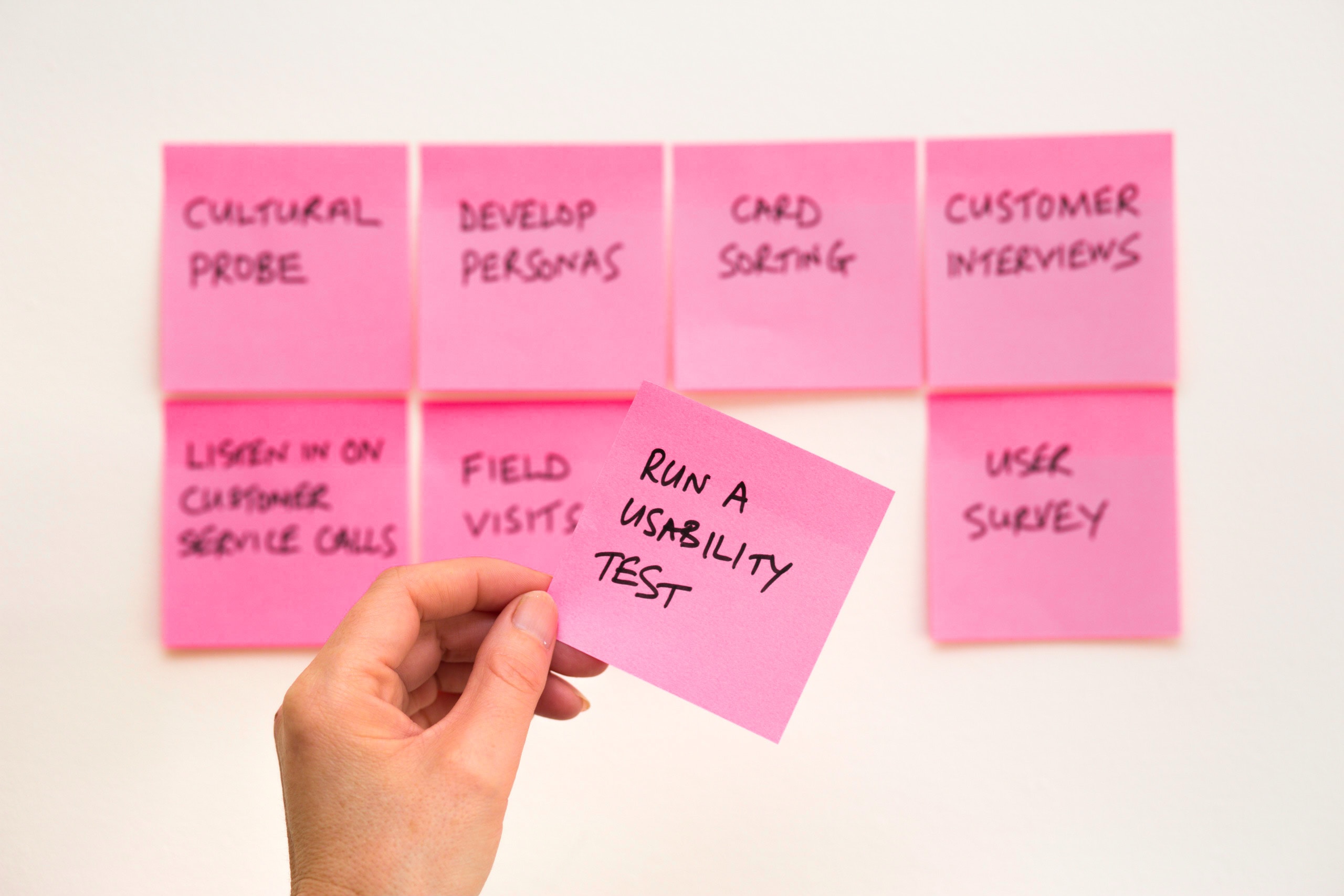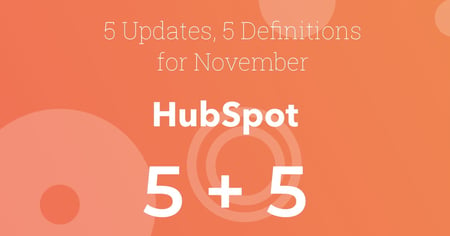When it comes to HubSpot, there’s a LOT to keep up on every week. We’re users ourselves, and partners, and it’s not easy.
Which is why we’re such fans of our own Sprocket Talk. Not because it’s under our brand. But because George B. Thomas is so good at keeping us up-to-date with everything going on!

Since you’re busy and probably can’t keep up with every single update, we decided to put up a short list of updates and definitions to freshen you up for the fourth quarter.
Grab a cup of coffee or tea and dive into these five HubSpot updates and five definitions you need for November.

Five HubSpot Updates
WordPress + HubSpot: Contacts, Lists and Reporting
Use HubSpot and WordPress together? You’re not alone. And now your integration is even better.
The HubSpot WordPress plugin now provides a dashboard that shows you the number of contacts you’ve generated on your site and gives you the ability to view your HubSpot contacts and lists without leaving WordPress.
Up until now, the plugin provided lead capture tools like forms and live chat but you had to leave WordPress and go into HubSpot to see how many contacts you’ve generated and who those contacts were.
Now, when you log into WordPress and go to the HubSpot plugin, you’ll see your HubSpot dashboard. This gives you a quick and easy view of how many contacts you’ve generated from your WordPress site.
You can also navigate to see all your contacts and see who’s in your database. When you’re ready to segment your contacts, you can head over to the lists tool to begin creating segmented lists to use for email campaigns and workflows.
You can navigate to each of these tools using the left-hand side navigation in your WordPress admin dashboard.
Watch the full HubSpot WordPress update here.
HubSpot + LinkedIn Lead Gen Ads
Technology. Ain’t it great?

It’s even easier to build Lead Gen Ads through LinkedIn by bringing them into HubSpot’s ad tools. Now you can create, target, and publish Lead Gen Ads without leaving HubSpot! All conversion data and contacts automatically sync back to your HubSpot reporting and contact database. Plus, with the pre-filled details from LinkedIn, you’re more likely to get detailed, accurate data for each lead.
Within the ads tool, click create campaign. You’ll see the option to create a LinkedIn lead gen campaign, in addition to Facebook lead ads.
The creation flow for LinkedIn lead gen ads is similar to the creation flow for Facebook lead ads. With LinkedIn lead gen ads, you’ll be able to leverage employment information in your ads targeting, like current employer, job title, and more.
This is now live to all users of HubSpot’s ads tool -- free through Marketing Hub Enterprise.
Check out the full video on HubSpot and LinkedIn Lead Gen Ads here.
HubSpot + GoToWebinar Updated 2019 Integration
Putting the power of GoToWebinar to work with your HubSpot platform can help take your webinar game to a whole new level. Now it’s even better.
GoToWebinar is the most-used webinar integration with HubSpot. But because it was one of the earliest, it was in need of a few updates.
You can now use simulated webinars for testing with all the power of live webinars. HubSpot also brings in more GoToWebinar fields with the new update, so you can see more data in the contact record.
In addition, since live webinars are reported to be very stressful for marketers, GoToWebinar added features like recorded webinar options and more. It’s all available in your integration without having to update anything on your own.
Customer Feedback Dashboard in Service Hub
The dashboard shows all of the results from all your surveys on one centralized screen. Nothing like putting all your data in one spot to make you more efficient!

There’s also a banner to help you get started with the feedback tool.
Don’t love a hundred tabs to coordinate all of your feedback? No worries! You can even create and manage all of your surveys from this single window.
No longer do you see the old welcome page when you sing into the tool. Now you see the dashboard with relevant information to get you started on your day.
Be sure to check out the full update with George as he covers the customer feedback dashboard in Service Hub here.
HubSpot Conversations + Facebook Messenger
Want to meet your audience where they are? Connect with people in Facebook Messenger through HubSpot with this new integration.
You can create a Messenger bot welcome experience on your Facebook Business page and manage all of your Messenger conversations from your Conversations inbox.
Plus, Sales Hub and Service Hub Professional and Enterprise tiers can automatically connect prospects and customers to the right people on your team (paid seats within Sales Hub and Service Hub only).
Keep this in mind: Each month, 20 billion messages are exchanged between people and businesses on Facebook Messenger. We also know that buyers have changed. Buyers now expect to have fluid 1:1 conversations with businesses through their favorite channels, at their pace, and on their terms.
Messenger is an enormous opportunity to connect directly with prospects and customers. Now, with Messenger in HubSpot Conversations and available on the mobile app, you can meet your buyers where they're at. With HubSpot’s Messenger integration, you can have more personal conversations, build stronger relationships, and remove friction from your customer's experience. Everyone across your organization—from Marketing to Sales to Service—can have full context of customer communications, helping you deliver a fluid end-to-end experience.
Get the full update plus the “how does it work” details in this update on HubSpot Conversations and Facebook Messenger.
Five Definitions

Sales Pipeline
A sales pipeline, or sales process, is a specific sequence of actions that a sales rep needs to take so they can guide a prospect from a sales qualified lead to a customer. Once each pipeline stage is completed, the prospect is advanced to the next stage.
These stages are Prospecting, Qualification or Meeting, Consideration, Decision or Proposal, and Closing.
It’s all about measuring, analyzing and iterating, right? A sales pipeline helps you track the progress of deals that your sales team is currently working on and expect to close within a reasonable amount of time.
From here you can plan your needed services, products, future marketing, and other company-wide initiatives. You can also plan for the ebb and flow of business.
Here’s how can you use an effective pipeline for your sales team.
Sales Pipelines for Better Follow Up
It may seem super obvious but you need to follow up! Whether you’re using a CRM with reminders, sequences like HubSpot uses or some other automation, managing your sales pipeline effectively starts with simply following up.
Sales Pipelines for Lead Focus
 Focus on the best leads and drop the dead leads. This could bring tools like lead scoring into your workflow, but it really comes down to managing your contacts well and understanding where they are in the sales process.
Focus on the best leads and drop the dead leads. This could bring tools like lead scoring into your workflow, but it really comes down to managing your contacts well and understanding where they are in the sales process.
You already know that the best prospects most likely to close typically have similar behaviors and time frames for closing. Look for those indicators. You also know when it’s time to let go of a lead. It’s best to use data like scores and grades as much as you can, but you also get to know your prospects. Use a mix of experience and data in your CRM tool.
Sales Pipelines for Monitoring Sales Metrics
Monitor pipeline metrics. Whether it’s a sales dashboard, regular check-ins, or setting up notifications, keeping an eye on your metrics like the number of deals in your sales pipeline, the average deal sizes and your close ratio all help you better manage the pipeline.
Set aside time on a weekly basis to regularly review these metrics so you have an ‘at a glance’ view of the health of your sales pipeline and your business. Tracking the results over time will also give you a strong indication of how any changes or improvements you make to your sales process are contributing towards overall growth.
Sales Pipelines for Content Mapping
Give your sales pipeline more content. Sure, phone calls and emails are at the heart of most sales communication. But you also know that much of the time prospects will require more information to help them understand if your product or service is right for their business.
For each step of the pipeline, think about what kind of content you can provide to your pipeline to help reinforce your message and guide them through to the next phase.
So, what kind of content should you be prepared to provide? The answer lies in listening to what your potential customers have to say.
During sales meetings, they’ll give you insight into the types of content they want at each stage of the pipeline. They might ask you for something as simple as “do you have an article that explains this?” or “is there a product sheet I can download?”
If you have this type of content, then send it. If not, then this information should be fed back into your marketing department.
Personalized 1:1 Marketing Videos
Personalized one-to-one marketing videos are basically video you create for your marketing efforts that include personalized messaging for the person watching it.
 This might mean saying their name, it could mean displaying their name on screen, maybe even using a company name.
This might mean saying their name, it could mean displaying their name on screen, maybe even using a company name.
It could even reference their location in a non-creepy way. Like “hope the spring in Kansas is beautiful, Candice!”
Personalized video marketing is a great new way to connect with prospects in the awareness and consideration phases of their journey with your brand.
Personalization is everywhere already. From email subject lines to relevant offers in our advertising feeds our content consumption continues to become more and more personalized.
In the meantime, personalized one-to-one marketing videos are important to your company because it shows that you’re paying attention.
If you can take the personalization tactics into the video you are creating, which by the way, already proves more “connecting” than just text, then you’ll be a marketing rock star for sure.
Use 1:1 marketing videos for your company. Personalized video marketing solutions like Vidyard can help you add tokens to videos so you’re using the data you have - first name, company, location - to personalize any video.
But what about using personalized videos in different areas of marketing? Here are four ways to do just that.
1:1 Marketing Videos: Confirmation Emails
Confirmation emails. Add a personalized video to these standard communications to really wow your prospects.
From subscription confirmations to meeting notices, you can add all kinds of videos. Imagine getting a thank you video for subscribing to a list, which then has your name on the screen!
1:1 Marketing Videos: Video Intros
Video intros for playlists. If a prospect has signed up for a video course or long form video content like a playlist, you could kick it all off with personalization by using tokens like Vidyard uses, adding their name to the screen.
That combined with a script that walks the line between generic and custom, you could make the viewer feel like it’s a completely personal touch. “We’re so glad you decided to start this video course. I personally know you’re going to find value in it. If you have any questions, please let me know right away.”
Fun videos. Whether it’s a culture video that you send to show off the team or a holiday offering, you could personalize these to make your prospect feel like part of the team.
1:1 Marketing Videos: Personalized Ads
Personalized ads. If you’re using video in advertising, can you find a way to personalize it with their names? Imagine seeing your name in an ad. How personal would that feel - as long as the ad is relevant in the first place?
1:1 Marketing Videos: Add Perceived Value
You can use personalized one-to-one marketing videos to help your prospects feel more valued and more connected to your brand. And now that you know what personalized one-to-one marketing videos are and why personalized one-to-one marketing videos are so important, make sure you are implementing this tool for your company’s success.
Programmatic Advertising and Marketing
Programmatic advertising and marketing is popular right now. As it gains popularity, it’s getting the attention of marketers looking for new ways to increase effective and cost-efficient growth. It’s also piquing curiosity of business owners and executives because of the potential cost-savings in their advertising budgets.
Basically, programmatic advertising is the automated buying and selling of online advertising. It uses auction-based software instead of manual negotiations. This automation makes transactions efficient and more effective, streamlining the process and consolidating your digital advertising efforts in one technology platform.
Programmatic advertising and marketing gives an advertiser the ability to pay for impressions based on the value of the eyeballs viewing their programmatic ad. It can all but eliminate the flat CPM across all impressions on a website.
Through the software, you get to send a bid for the ad view based on the value you’ve assigned to a variety of variables. These can include time of day, device, website, user cookie details, and more. This increases both the targeting and efficiency of advertising.
You can use programmatic advertising and marketing for your company.
Programmatic Advertising and Marketing: Use the Pixel
Use your pixel! Be a ninja about it! Whether you’re running an awareness, consideration, or direct response marketing campaign, you should set up conversion tracking. Retarget from valuable areas of your website. Create lookalikes to use in your prospecting campaigns.
Programmatic Advertising and Marketing: Channel Performance
Test, test, TEST! Look at how different channels perform. It’s not easy to move budget away from a channel that works and test a new channel you haven’t used before. But one of the benefits of programmatic advertising is there a lot of partners that have inventory for multiple channels.

As an example, maybe you’re running Facebook ads. They work pretty well. Consider testing a run with display ads on websites, connected TV, or programmatic video.Test channels directly against each other, measure results and double down on the winner!
Programmatic Advertising and Marketing: Content Alignment
Align your advertising channel with your content, target audience, and campaign goals. It’s vital to align your channel to every piece of your campaign. Channel performance can vary widely based on many factors.
Some content pieces may work well with display, while others may perform better with native. And not all channels are created equal for all campaign goals.
Buyer Persona
Back to basics. Are you using buyer personas in your marketing? A buyer persona is a fictional character you create to represent a prospect or customer who might consider doing business with you.
It’s helpful to create a narrative with a real name and an image, to really help humanize your customers - and prospects! Make sure they’re fictional. Don’t use one customer as a buyer persona template for all of them.
Creating buyer personas will do a few things for your brand. Marketing uses buyer personas to drive the right kind of awareness and engagement
When marketers know who to go after, they can be laser-focused and more efficient. Plus it help you humanize your brand and speak to your ideal customers better.
For sales, buyer personas can increase efficiency in lead nurturing and help frame conversations to better-build trust.
When creating your personas, you could use a buyer persona template. Or you could start from scratch. Either way, consider including customer demographics, behavior patterns, motivations, and goals. The more detailed you are, the better.
Buyer Personas as a Conversational Tool
Use personas in your forms and conversational tools. Ask “How do you describe yourself,” then offer descriptions. For instance, one of our personas at Impulse Creative is Owner Ollie. So the answer would be, “I’m a CEO or Business Owner looking to grow my business.” This helps you segment your contacts from the beginning.
Buyer Personas for Smart Content
Use buyer personas in smart content on your home page. You can speak directly to the person and their journey by using the language that means something to them. Again, with Owner Ollie, if we know who you are at Impulse Creative, we can offer headlines like “We help Business Owners like you turn your website into a revenue source.”
Buyer Personas for Content Creation
A well-defined buyer persona should include where they spend their time and where they gather information. This is why using data like surveying your existing customers is so important. You should have a good idea of what social media your persona uses, and how they research their problems.
This way you can produce the right content, push it to the most efficient channels - like do they read everything on Medium? - and use tools like social media retargeting to stay with them. But if they use LinkedIn and don’t use Instagram, then you’d want to focus your efforts in the right place.
Newsletter Specificity with Buyer Persona's
And finally, put those personas to work in your email newsletters. Personalization is more than using names and companies. What if you made a monthly newsletter with smart content? You could send Owner Ollie resources that matter to them, while sending Marketing Mary the articles that matter to her.
The content is likely different. So if you serve them the same old thing, your email open and click rates suffer and you aren’t bringing value. But if you put your buyer personas to work, you can use segmentation and personalization like a ninja.
Now that you know what a buyer persona is and why buyer personas are so important, make sure you are implementing them for your company’s success.
Make sure you're being happy and helpful, human along the way and let us know how you are using one-to-one videos at your company.
Closed Loop Marketing
This marketing strategy relies on data and insights from closed-loop reporting. “Closing the loop” just means that sales teams report to marketing about what happened to the leads they got from marketing, so everyone is on the same page.
No more guessing! That’s right, guessing at your business strategy is always a losing proposition.

Closed-loop marketing helps you focus on the channels and campaigns that matter most. Plus it minimizes the cost-per-lead. When you know what channels and campaigns close the most sales, you can stop wasting efforts on those that don’t. BOOM… Cost savings! There are more reasons… but those alone make it clear that closing the loop is good for business.
In order to use this at your company, you basically need good communication between sales and marketing. Have someone take ownership of the process. Of course, there are closed-loop marketing software solutions, too.
Connect your teams and efforts with tools that bring marketing, CRM, social media, email and everything else together. That might be HubSpot, Marketo, Salesforce… there are more than 7,000 marketing tech solutions out there.
Lock Your Buyer Personas In With Closed Loop Marketing!
You can use closed-loop marketing to make sure your buyer personas are locked in. The insights you gain from closing your loop between marketing and sales will give you the most comprehensive view of your leads and customers.
Most companies assume they know their audience. With closed-loop marketing, you’ll really know them by dashing assumptions and using data!
Shorten Your Sales Cycle With Closed Loop Marketing!
You can use closed-loop marketing to shorten the sales cycle. Identify the pivotal touch points along your buyer’s journey.
Lean into those, improve them, put resources like automation into play and help shorten the sales cycle.You’ll remove the noise that may distract or slow down the funnel.
See Tangible Results With Closed Loop Marketing!
Leadership will see tangible results of marketing efforts. This new way helps to see how marketing’s efforts truly impact the company because it shows which channels help make the most profit.
Now that you know what closed loop marketing is and why closed loop marketing is important, make sure you are implementing it for your company’s growth success.
Make sure you're being happy and helpful, human along the way and, we will see you on the next What Is article!
Want more great content like this more often? Subscribe to our biweekly newsletter.





